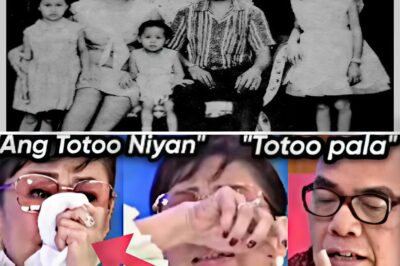Nora Cabaltera Villamayor was born on May 21, 1953, and almost from the start she seemed destined for a life of dramatic lows combined with ecstatic highs.

She was born to abject poverty in the town of Iriga, Camarines Sur, a sickly child prone to chills and convulsions. When she was seven years old, she experienced a particularly horrible convulsion during which she coughed up blood. But the child recovered and suffered no more fits after that.
By all accounts, Nora was a first-honors student from Grade 1 to 5. But she discovered pop music and movies in sixth grade, at which point she started singing.
In 1963, during her first year of high school, her elder sister, who was then in senior year, needed 20 pesos to complete her tuition. Nora joined the Darigold Jamboree singing contest in Naga, and won exactly that amount when she was proclaimed winner.
But Nora’s win did not change her circumstances. Her family still had to deal with hunger and starvation every day. One night, when her Papay still hadn’t returned from the train station with his daily earnings as a porter, Nora walked from store to store, begging to be given rice on credit.
The difference now was that Nora’s victory fueled sly digs from storeowners telling her to join more contests so that she could pay for the rice. To make matters worse, when she finally got the rice, she spilled some of it and was forced to pick up every single grain before she could return home.
And when she got back to the family’s two-room nipa hut, her mother pinched and scolded her for her carelessness. The weeping 12-year-old began to wonder if her victory in Naga was more of a curse than a blessing.
Swinging between boon and bane was to be a recurring theme in Nora’s life.
In the article “Golden Girl,” originally published in a July 1970 issue of the Philippines Free Press and reprinted in the book Nora Aunor and Other Profiles (National Book Store, 1977), National Artist Nick Joaquin, writing as Quijano de Manila, put it this way: “It looked as if the poor, thin, homely child had, after all, a fairy godmother to take care of her. It must be a funny sort of fairy godmother because when this fairy godmother grants a blessing she always mixes a heap of trouble with the good fortune.”
Nora herself has her own explanation for that “heap of trouble” that has been her lot since birth. In an interview with YES!, award-winning scriptwriter Ricky Lee recalls Nora telling him that her mother, when pregnant with Nora, had taken a liking—in local parlance, ipinaglihi—to the Mater Dolorosa, the weeping image of the Virgin Mary with seven daggers stabbed into her heart.
Ricky says Nora told him: “Kaya, kuya, pag tinitingnan mo ako sa mata ko, maski ako nakatawa, malungkot ako dahil sa lalim ng pagkakatarak.”
She added, “‘Yong punyal doon sa birhen, nakalantad. Kaya ako, wala akong maitago, e. Nakatarak ang punyal sa dibdib ko, nakalantad sa tao, all these years.”
When the superstar Nora Aunor passed away on April 16, many people started asking—were any of her relatives present? Did any cousins, nieces, nephews, or siblings come to see her for the last time? Actually, even the media didn’t report anything. None of her siblings or her children—Lotlot, Ian, Matet, Kenneth, or Kiko—made any public statement about this. Social media and reporters didn’t seem to ask whether any family members visited her during her final moments.
This led many to wonder: Does the late superstar still have living siblings?
According to an article about Nora Aunor’s early life and education, she was born in Barrio San Francisco, Iriga, Camarines Sur, in the Bicol Region. Her parents were Antonia Cabaltera and Eustaquio Villamayor. She had nine siblings, including Eddie Villamayor (also known as Eddie Villamor), who was once an actor.
This means that Nora also had a sibling who worked in showbiz. But was he an actor before Nora entered the industry, or did she come first? Based on her biography, Nora Aunor became the breadwinner of their family.
Her aunt Mamayen was the one who taught her proper diction, interpretation, and emotional expression in singing. It was under her aunt’s care that Nora began to grow. Her stage name was also influenced by her relatives. She first won a local contest called Darigold Jamboree, where she sang “You and the Night and the Music.” After that, she won another contest, The Liberty Big Show.
Eventually, Nora joined the national singing competition Tawag ng Tanghalan. Although she lost in her first try, she came back and became the grand champion in the national finals on May 29, 1967, singing “Moonlight Becomes You.”
Regarding her education, Nora attended Mabini College for first grade in 1959–1960. She then transferred to Nicolas Airbase Elementary School for grades 2 and 3 (1960–1962), then moved to Iriga Central Elementary School for grades 4 and 5 (1962–1964). She returned to Mabini Memorial College for 6th grade (1965–1966). For high school, she studied at Centro Escolar University in Parañaque during her second and third years, and completed her fourth year between 1970 and 1971.
News
“Sasabihin ko ang buong katotohanan!” — Binasag ni Cherry Pie Picache ang katahimikan sa mga paratang sa pang-aabuso ni Edu Manzano…
Manila — In a revelation that shocked both fans and the entertainment world, veteran actress Cherry Pie Picache has finally opened up about…
Bea Alonzo Engaged to Billionaire’s Son — Fans Can’t Get Enough! [Full Video]
Sometimes, we make many plans in life, but God’s plans are always better. Fans of Bea Alonzo are overjoyed because,…
Tumulo ang Luha Parang Ulan!! VILMA SANTOS Nanginginig sa Damdamin — Ibinunyag ang Nakakalokang Katotohanan kay TITO BOY Tungkol kay LUIS MANZANO! “Hindi ko na kayang itago ang sikretong ito…
Tears Flowed Freely: Vilma Santos Emotionally Opens Up to Tito Boy About the Truth Concerning Luis Manzano In a deeply…
Coco Martin, Pag-aagawan Nina Kim Domingo, Andrea Brillantes at Angeli Khang
Isang bagong mukha ang aabangan ng mga manonood sa primetime action-drama na “FPJ’s Batang Quiapo.” Ipinakilala kamakailan na makakasama na sa…
Ano ang ginagawa ni Kim Chiu? Bakit Siya Willing na Maging ‘Alipin’ ni Paulo Avelino
Muling naging laman ng usap-usapan sa social media ang aktres na si Kim Chiu, matapos niyang paulit-ulit na batiin…
Finally, She Speaks! Claudine Barretto Makes a Shocking Revelation About Marjorie – I Can’t Keep Quiet Anymore …
Sa isang emosyonal na panayam na agad umani ng milyong views online, nagsalita na sa wakas si Claudine Barretto tungkol…
End of content
No more pages to load












